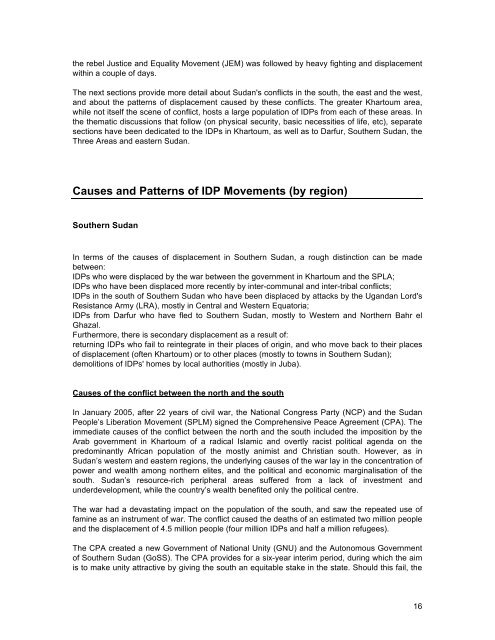SUDAN: Durable solutions elusive as southern IDPs return and ...
SUDAN: Durable solutions elusive as southern IDPs return and ...
SUDAN: Durable solutions elusive as southern IDPs return and ...
Create successful ePaper yourself
Turn your PDF publications into a flip-book with our unique Google optimized e-Paper software.
the rebel Justice <strong>and</strong> Equality Movement (JEM) w<strong>as</strong> followed by heavy fighting <strong>and</strong> displacement<br />
within a couple of days.<br />
The next sections provide more detail about Sudan's conflicts in the south, the e<strong>as</strong>t <strong>and</strong> the west,<br />
<strong>and</strong> about the patterns of displacement caused by these conflicts. The greater Khartoum area,<br />
while not itself the scene of conflict, hosts a large population of <strong>IDPs</strong> from each of these are<strong>as</strong>. In<br />
the thematic discussions that follow (on physical security, b<strong>as</strong>ic necessities of life, etc), separate<br />
sections have been dedicated to the <strong>IDPs</strong> in Khartoum, <strong>as</strong> well <strong>as</strong> to Darfur, Southern Sudan, the<br />
Three Are<strong>as</strong> <strong>and</strong> e<strong>as</strong>tern Sudan.<br />
Causes <strong>and</strong> Patterns of IDP Movements (by region)<br />
Southern Sudan<br />
In terms of the causes of displacement in Southern Sudan, a rough distinction can be made<br />
between:<br />
<strong>IDPs</strong> who were displaced by the war between the government in Khartoum <strong>and</strong> the SPLA;<br />
<strong>IDPs</strong> who have been displaced more recently by inter-communal <strong>and</strong> inter-tribal conflicts;<br />
<strong>IDPs</strong> in the south of Southern Sudan who have been displaced by attacks by the Ug<strong>and</strong>an Lord's<br />
Resistance Army (LRA), mostly in Central <strong>and</strong> Western Equatoria;<br />
<strong>IDPs</strong> from Darfur who have fled to Southern Sudan, mostly to Western <strong>and</strong> Northern Bahr el<br />
Ghazal.<br />
Furthermore, there is secondary displacement <strong>as</strong> a result of:<br />
<strong>return</strong>ing <strong>IDPs</strong> who fail to reintegrate in their places of origin, <strong>and</strong> who move back to their places<br />
of displacement (often Khartoum) or to other places (mostly to towns in Southern Sudan);<br />
demolitions of <strong>IDPs</strong>' homes by local authorities (mostly in Juba).<br />
Causes of the conflict between the north <strong>and</strong> the south<br />
In January 2005, after 22 years of civil war, the National Congress Party (NCP) <strong>and</strong> the Sudan<br />
People’s Liberation Movement (SPLM) signed the Comprehensive Peace Agreement (CPA). The<br />
immediate causes of the conflict between the north <strong>and</strong> the south included the imposition by the<br />
Arab government in Khartoum of a radical Islamic <strong>and</strong> overtly racist political agenda on the<br />
predominantly African population of the mostly animist <strong>and</strong> Christian south. However, <strong>as</strong> in<br />
Sudan’s western <strong>and</strong> e<strong>as</strong>tern regions, the underlying causes of the war lay in the concentration of<br />
power <strong>and</strong> wealth among northern elites, <strong>and</strong> the political <strong>and</strong> economic marginalisation of the<br />
south. Sudan’s resource-rich peripheral are<strong>as</strong> suffered from a lack of investment <strong>and</strong><br />
underdevelopment, while the country’s wealth benefited only the political centre.<br />
The war had a dev<strong>as</strong>tating impact on the population of the south, <strong>and</strong> saw the repeated use of<br />
famine <strong>as</strong> an instrument of war. The conflict caused the deaths of an estimated two million people<br />
<strong>and</strong> the displacement of 4.5 million people (four million <strong>IDPs</strong> <strong>and</strong> half a million refugees).<br />
The CPA created a new Government of National Unity (GNU) <strong>and</strong> the Autonomous Government<br />
of Southern Sudan (GoSS). The CPA provides for a six-year interim period, during which the aim<br />
is to make unity attractive by giving the south an equitable stake in the state. Should this fail, the<br />
16
















